参考文档:
- Github project:https://github.com/heketi/heketi
- MANAGING VOLUMES USING HEKETI:https://access.redhat.com/documentation/en-us/red_hat_gluster_storage/3.3/html/administration_guide/ch05s02
- StorageClass:https://kubernetes.io/docs/concepts/storage/storage-classes/
- StorageClass(中文):https://k8smeetup.github.io/docs/concepts/storage/storage-classes/
- Dynamic Volume Provisioning:https://kubernetes.io/docs/concepts/storage/dynamic-provisioning/
一.Heketi简介
1. 简介
Heketi是一个提供RESTful API管理GlusterFS卷的框架,便于管理员对GlusterFS进行操作:
- 可以用于管理GlusterFS卷的生命周期;
- 能够在OpenStack,Kubernetes,Openshift等云平台上实现动态存储资源供应(动态在GlusterFS集群内选择bricks构建volume);
- 支持GlusterFS多集群管理。
2. 框架
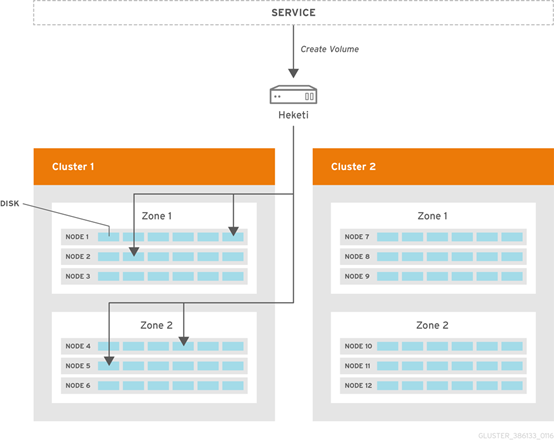
- Heketi支持GlusterFS多集群管理;
-
在集群中通过zone区分故障域。
二.环境
1. 环境
Kubernetes与GlusterFS集群已提前部署完成,请参考:
- Kubernetes:https://www.cnblogs.com/netonline/tag/kubernetes/
-
注意:GlusterFS只需要安装并启动即可,不必组建受信存储池(trusted storage pools)
| Hostname |
IP |
Remark |
| kubenode1 |
172.30.200.21 |
|
| kubenode2 |
172.30.200.22 |
|
| kubenode3 |
172.30.200.23 |
|
| heketi |
172.30.200.80 |
selinux disabled |
| glusterfs01 |
172.30.200.81 |
|
| glusterfs02 |
172.30.200.82 |
|
| glusterfs03 |
172.30.200.83 |
2. 设置iptables
# 设置iptables,heketi默认以tcp8080端口提供RESTful API服务;
[root@heketi ~]# vim /etc/sysconfig/iptables
-A INPUT -p tcp -m state --state NEW -m tcp --dport 8080 -j ACCEPT
[root@heketi ~]# service iptables restart
三.部署heketi
1. 安装heketi
# 添加gluster yum源,默认yum源中无相关package;
# heketi:heketi服务;
# heketi-client:heketi客户端/命令行工具
# --cluster-store:连接etcd,docker支持跨主机的多节点网络时,需要设置此参数,否则网络元数据无法协同
[root@heketi ~]# yum install -y centos-release-gluster
[root@heketi ~]# yum install -y heketi heketi-client
2. 配置heketi.json
# 注意红色字体是修改部分;
[root@heketi ~]# vim /etc/heketi/heketi.json
{
# 默认端口tcp8080
"_port_comment": "Heketi Server Port Number",
"port": "8080",
# 默认值false,不需要认证
"_use_auth": "Enable JWT authorization. Please enable for deployment",
"use_auth": true,
"_jwt": "Private keys for access",
"jwt": {
"_admin": "Admin has access to all APIs",
"admin": {
"key": "admin@123"
},
"_user": "User only has access to /volumes endpoint",
"user": {
"key": "user@123"
}
},
"_glusterfs_comment": "GlusterFS Configuration",
"glusterfs": {
"_executor_comment": [
"Execute plugin. Possible choices: mock, ssh",
"mock: This setting is used for testing and development.",
" It will not send commands to any node.",
"ssh: This setting will notify Heketi to ssh to the nodes.",
" It will need the values in sshexec to be configured.",
"kubernetes: Communicate with GlusterFS containers over",
" Kubernetes exec api."
],
# mock:测试环境下创建的volume无法挂载;
# kubernetes:在GlusterFS由kubernetes创建时采用
"executor": "ssh",
"_sshexec_comment": "SSH username and private key file information",
"sshexec": {
"keyfile": "/etc/heketi/heketi_key",
"user": "root",
"port": "22",
"fstab": "/etc/fstab"
},
"_kubeexec_comment": "Kubernetes configuration",
"kubeexec": {
"host" :"https://kubernetes.host:8443",
"cert" : "/path/to/crt.file",
"insecure": false,
"user": "kubernetes username",
"password": "password for kubernetes user",
"namespace": "OpenShift project or Kubernetes namespace",
"fstab": "Optional: Specify fstab file on node. Default is /etc/fstab"
},
"_db_comment": "Database file name",
"db": "/var/lib/heketi/heketi.db",
"_loglevel_comment": [
"Set log level. Choices are:",
" none, critical, error, warning, info, debug",
"Default is warning"
],
# 默认设置为debug,不设置时的默认值即是warning;
# 日志信息输出在/var/log/message
"loglevel" : "warning"
}
}
3. 设置heketi免密访问GlusterFS
# 选择ssh执行器,heketi服务器需要免密登陆GlusterFS集群的各节点;
# -t:秘钥类型;
# -q:安静模式;
# -f:指定生成秘钥的目录与名字,注意与heketi.json的ssh执行器中"keyfile"值一致;
# -N:秘钥密码,""即为空
[root@heketi ~]# ssh-keygen -t rsa -q -f /etc/heketi/heketi_key -N ""
# heketi服务由heketi用户启动,heketi用户需要有新生成key的读赋权,否则服务无法启动
[root@heketi ~]# chown heketi:heketi /etc/heketi/heketi_key
# 分发公钥;
# -i:指定公钥
[root@heketi ~]# ssh-copy-id -i /etc/heketi/heketi_key.pub [email protected]
[root@heketi ~]# ssh-copy-id -i /etc/heketi/heketi_key.pub [email protected]
[root@heketi ~]# ssh-copy-id -i /etc/heketi/heketi_key.pub [email protected]
4. 启动heketi
# 通过yum安装heketi,默认的systemd文件有1处错误;
# /usr/lib/systemd/system/heketi.service文件的"-config=/etc/heketi/heketi.json"应该修改为"--config=/etc/heketi/heketi.json";
# 否则启动时报"Error: unknown shorthand flag: 'c' in -config=/etc/heketi/heketi.json"错,导致服务无法启动
[root@heketi ~]# systemctl enable heketi
[root@heketi ~]# systemctl restart heketi
[root@heketi ~]# systemctl status heketi
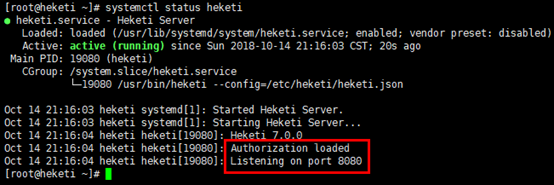
# 验证
[root@heketi ~]# curl http://localhost:8080/hello

四.设置GlusterFS集群
1. 创建topology.json文件
# 通过topology.json文件定义组建GlusterFS集群;
# topology指定了层级关系:clusters-->nodes-->node/devices-->hostnames/zone;
# node/hostnames字段的manage填写主机ip,指管理通道,在heketi服务器不能通过hostname访问GlusterFS节点时间不能填写hostname;
# node/hostnames字段的storage填写主机ip,指存储数据通道,与manage可以不一样;
# node/zone字段指定了node所处的故障域,heketi通过跨故障域创建副本,提高数据高可用性质,如可以通过rack的不同区分zone值,创建跨机架的故障域;
# devices字段指定GlusterFS各节点的盘符(可以是多块盘),必须是未创建文件系统的裸设备
[root@heketi ~]# vim /etc/heketi/topology.json
{
"clusters": [
{
"nodes": [
{
"node": {
"hostnames": {
"manage": [
"172.30.200.81"
],
"storage": [
"172.30.200.81"
]
},
"zone": 1
},
"devices": [
"/dev/sdb"
]
},
{
"node": {
"hostnames": {
"manage": [
"172.30.200.82"
],
"storage": [
"172.30.200.82"
]
},
"zone": 2
},
"devices": [
"/dev/sdb"
]
},
{
"node": {
"hostnames": {
"manage": [
"172.30.200.83"
],
"storage": [
"172.30.200.83"
]
},
"zone": 3
},
"devices": [
"/dev/sdb"
]
}
]
}
]
}
2. 通过topology.json组建GlusterFS集群
# GlusterFS集群各节点的glusterd服务已正常启动,但不必组建受信存储池;
# heketi-cli命令行也可手动逐层添加cluster,node,device,volume等;
# "--server http://localhost:8080":localhost执行heketi-cli时,可不指定;
# "--user admin --secret admin@123 ":heketi.json中设置了认证,执行heketi-cli时需要带上认证信息,否则报"Error: Invalid JWT token: Unknown user"错
[root@heketi ~]# heketi-cli --server http://localhost:8080 --user admin --secret admin@123 topology load --json=/etc/heketi/topology.json

# 查看heketi topology信息,此时volume与brick等未创建;
# 通过"heketi-cli cluster info"可以查看集群相关信息;
# 通过"heketi-cli node info"可以查看节点相关信息;
# 通过"heketi-cli device info"可以查看device相关信息
[root@heketi ~]# heketi-cli --user admin --secret admin@123 topology info
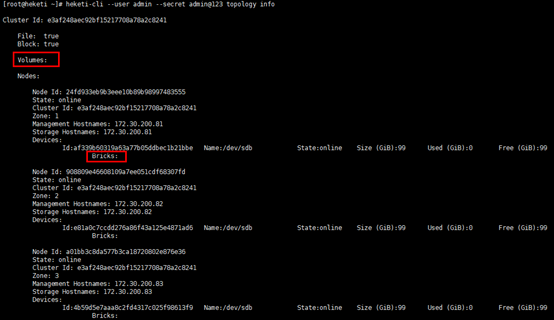
五.K8S集群动态挂载GlusterFS存储
1. 基于StorageClass的动态存储流程
kubernetes共享存储供应模式:
-
静态模式(Static):集群管理员手工创建PV,在定义PV时需设置后端存储的特性;
-
动态模式(Dynamic):集群管理员不需要手工创建PV,而是通过StorageClass的设置对后端存储进行描述,标记为某种"类型(Class)";此时要求PVC对存储的类型进行说明,系统将自动完成PV的创建及与PVC的绑定;PVC可以声明Class为"",说明PVC禁止使用动态模式。
基于StorageClass的动态存储供应整体过程如下图所示:

-
集群管理员预先创建存储类(StorageClass);
-
用户创建使用存储类的持久化存储声明(PVC:PersistentVolumeClaim);
-
存储持久化声明通知系统,它需要一个持久化存储(PV: PersistentVolume);
-
系统读取存储类的信息;
-
系统基于存储类的信息,在后台自动创建PVC需要的PV;
-
用户创建一个使用PVC的Pod;
-
Pod中的应用通过PVC进行数据的持久化;
-
而PVC使用PV进行数据的最终持久化处理。
2. 定义StorageClass
# provisioner:表示存储分配器,需要根据后端存储的不同而变更;
# reclaimPolicy: 默认即"Delete",删除pvc后,相应的pv及后端的volume,brick(lvm)等一起删除;设置为"Retain"时则保留数据,需要手工处理
# resturl:heketi API服务提供的url;
# restauthenabled:可选参数,默认值为"false",heketi服务开启认证时必须设置为"true";
# restuser:可选参数,开启认证时设置相应用户名;
# secretNamespace:可选参数,开启认证时可以设置为使用持久化存储的namespace;
# secretName:可选参数,开启认证时,需要将heketi服务的认证密码保存在secret资源中;
# clusterid:可选参数,指定集群id,也可以是1个clusterid列表,格式为"id1,id2";
# volumetype:可选参数,设置卷类型及其参数,如果未分配卷类型,则有分配器决定卷类型;如"volumetype: replicate:3"表示3副本的replicate卷,"volumetype: disperse:4:2"表示disperse卷,其中'4'是数据,'2'是冗余校验,"volumetype: none"表示distribute卷#
[root@kubenode1 ~]# mkdir -p heketi
[root@kubenode1 ~]# cd heketi/
[root@kubenode1 heketi]# vim gluster-heketi-storageclass.yaml
apiVersion: storage.k8s.io/v1
kind: StorageClass
metadata:
name: gluster-heketi-storageclass
provisioner: kubernetes.io/glusterfs
reclaimPolicy: Delete
parameters:
resturl: "http://172.30.200.80:8080"
restauthenabled: "true"
restuser: "admin"
secretNamespace: "default"
secretName: "heketi-secret"
volumetype: "replicate:2"
# 生成secret资源,其中"key"值需要转换为base64编码格式
[root@kubenode1 heketi]# echo -n "admin@123" | base64
# 注意name/namespace与storageclass资源中定义一致;
# 密码必须有"kubernetes.io/glusterfs" type
[root@kubenode1 heketi]# cat heketi-secret.yaml
apiVersion: v1
kind: Secret
metadata:
name: heketi-secret
namespace: default
data:
# base64 encoded password. E.g.: echo -n "mypassword" | base64
key: YWRtaW5AMTIz
type: kubernetes.io/glusterfs

# 创建secret资源
[root@kubenode1 heketi]# kubectl create -f heketi-secret.yaml
# 创建storageclass资源;
# 注意:storageclass资源创建后不可变更,如修改只能删除后重建
[root@kubenode1 heketi]# kubectl create -f gluster-heketi-storageclass.yaml

# 查看storageclass资源
[root@kubenode1 heketi]# kubectl describe storageclass gluster-heketi-storageclass

3. 定义PVC
1)定义PVC
# 注意"storageClassName"的对应关系
[root@kubenode1 heketi]# vim gluster-heketi-pvc.yaml
kind: PersistentVolumeClaim
apiVersion: v1
metadata:
name: gluster-heketi-pvc
spec:
storageClassName: gluster-heketi-storageclass
# ReadWriteOnce:简写RWO,读写权限,且只能被单个node挂载;
# ReadOnlyMany:简写ROX,只读权限,允许被多个node挂载;
# ReadWriteMany:简写RWX,读写权限,允许被多个node挂载;
accessModes:
- ReadWriteOnce
resources:
requests:
# 注意格式,不能写"GB"
storage: 1Gi
# 创建pvc资源
[root@kubenode1 heketi]# kubectl create -f gluster-heketi-pvc.yaml
2)查看k8s资源
# 查看PVC,状态为"Bound";
# "Capacity"为2G,是因为同步创建meta数据
[root@kubenode1 heketi]# kubectl describe pvc gluster-heketi-pvc

# 查看PV详细信息,除容量,引用storageclass信息,状态,回收策略等外,同时给出GlusterFS的Endpoint与path;
[root@kubenode1 heketi]# kubectl get pv
[root@kubenode1 heketi]# kubectl describe pv pvc-532cb8c3-cfc6-11e8-8fde-005056bfa8ba
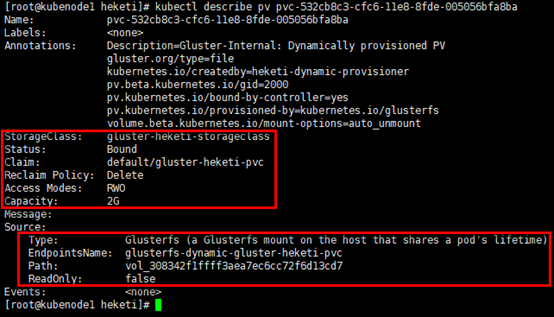
# 查看endpoints资源,可以从pv信息中获取,固定格式:glusterfs-dynamic-PVC_NAME;
# endpoints资源中指定了挂载存储时的具体地址
[root@kubenode1 heketi]# kubectl describe endpoints glusterfs-dynamic-gluster-heketi-pvc

3)查看heketi
# volume与brick已经创建;
# 主挂载点(通信)在glusterfs01节点,其余两个节点备选;
# 两副本的情况下,glusterfs03节点并未创建brick
[root@heketi ~]# heketi-cli --user admin --secret admin@123 topology info

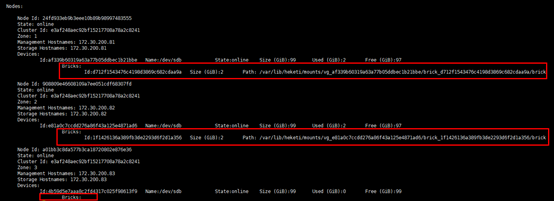
4)查看GlusterFS节点
# 以glusterfs01节点为例
[root@glusterfs01 ~]# lsblk

[root@glusterfs01 ~]# df -Th

# 查看volume的具体信息:2副本的replicate卷;
# 另有"vgscan","vgdisplay"也可查看逻辑卷组信息等
[root@glusterfs01 ~]# gluster volume list
[root@glusterfs01 ~]# gluster volume info vol_308342f1ffff3aea7ec6cc72f6d13cd7

4. Pod挂载存储资源
# 设置1个volume被pod引用,volume的类型为"persistentVolumeClaim"
[root@kubenode1 heketi]# vim gluster-heketi-pod.yaml
kind: Pod
apiVersion: v1
metadata:
name: gluster-heketi-pod
spec:
containers:
- name: gluster-heketi-container
image: busybox
command:
- sleep
- "3600"
volumeMounts:
- name: gluster-heketi-volume
mountPath: "/pv-data"
readOnly: false
volumes:
- name: gluster-heketi-volume
persistentVolumeClaim:
claimName: gluster-heketi-pvc
# 创建pod
[root@kubenode1 heketi]# kubectl create -f gluster-heketi-pod.yaml
5. 验证
# 在容器的挂载目录中创建文件
[root@kubenode1 heketi]# kubectl exec -it gluster-heketi-pod /bin/sh
/ # cd /pv-data
/pv-data # echo "This is a file!" >> a.txt
/pv-data # echo "This is b file!" >> b.txt
/pv-data # ls

# 在GlusterFS节点对应挂载目录查看创建的文件;
# 挂载目录通过"df -Th"或"lsblk"获取
[root@glusterfs01 ~]# df -Th
[root@glusterfs01 ~]# cd /var/lib/heketi/mounts/vg_af339b60319a63a77b05ddbec1b21bbe/brick_d712f1543476c4198d3869c682cdaa9a/brick/
[root@glusterfs01 brick]# ls
[root@glusterfs01 brick]# cat a.txt
[root@glusterfs01 brick]# cat b.txt

6. 验证StorageClass的ReclaimPolicy
# 删除Pod应用后,再删除pvc
[root@kubenode1 heketi]# kubectl delete -f gluster-heketi-pod.yaml
[root@kubenode1 heketi]# kubectl delete -f gluster-heketi-pvc.yaml
# k8s资源
[root@kubenode1 heketi]# kubectl get pvc
[root@kubenode1 heketi]# kubectl get pv
[root@kubenode1 heketi]# kubectl get endpoints

# heketi
[root@heketi ~]# heketi-cli --user admin --secret admin@123 topology info
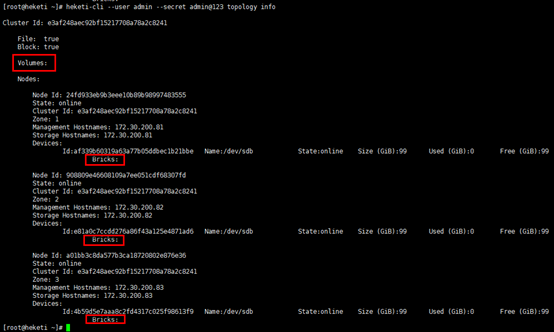
# GlusterFS节点
[root@glusterfs01 ~]# lsblk
[root@glusterfs01 ~]# df -Th
[root@glusterfs01 ~]# gluster volume list
